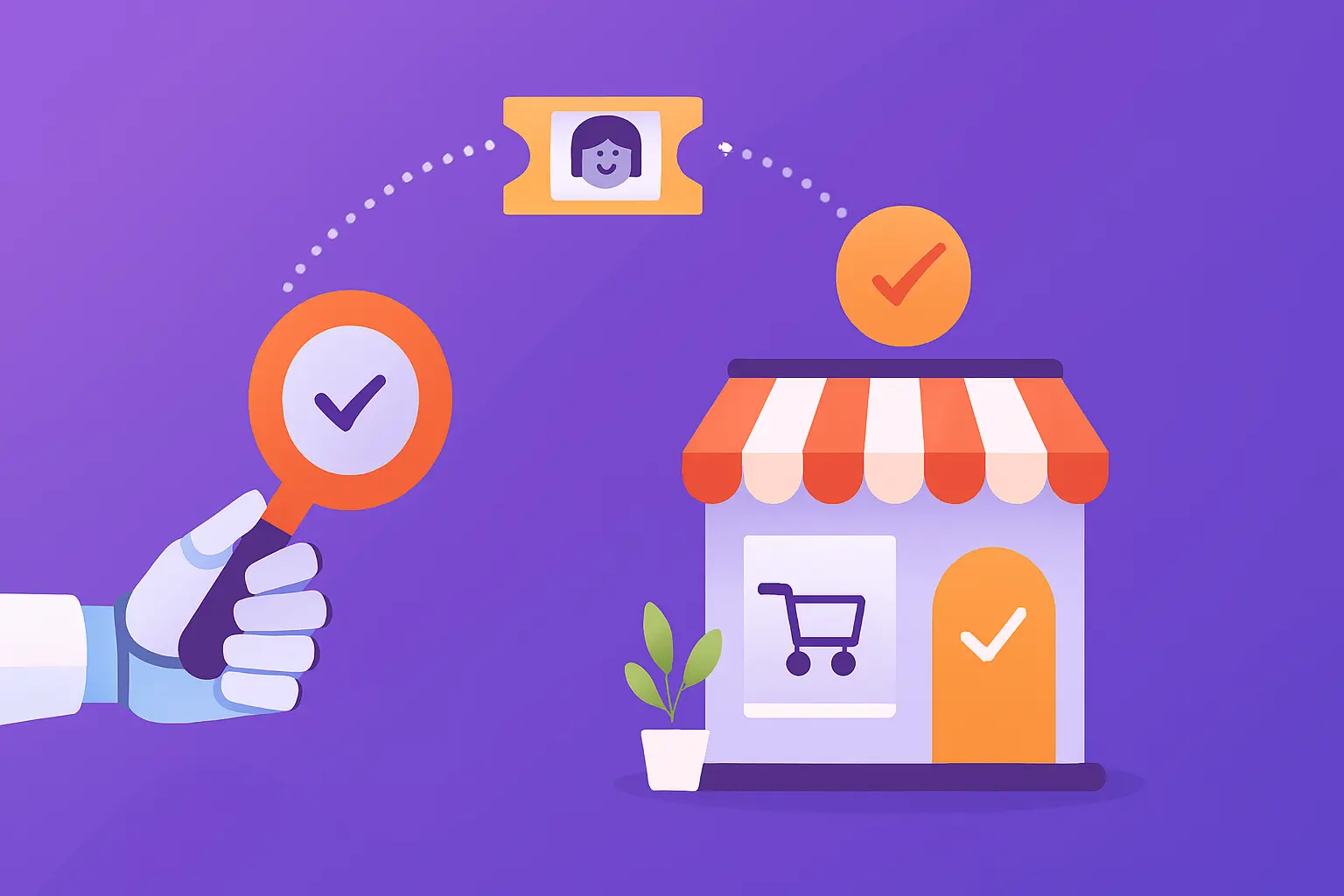Customer Journey Mapping: Importance & Examples
- January 25, 2023
- 14 mins read
- Listen
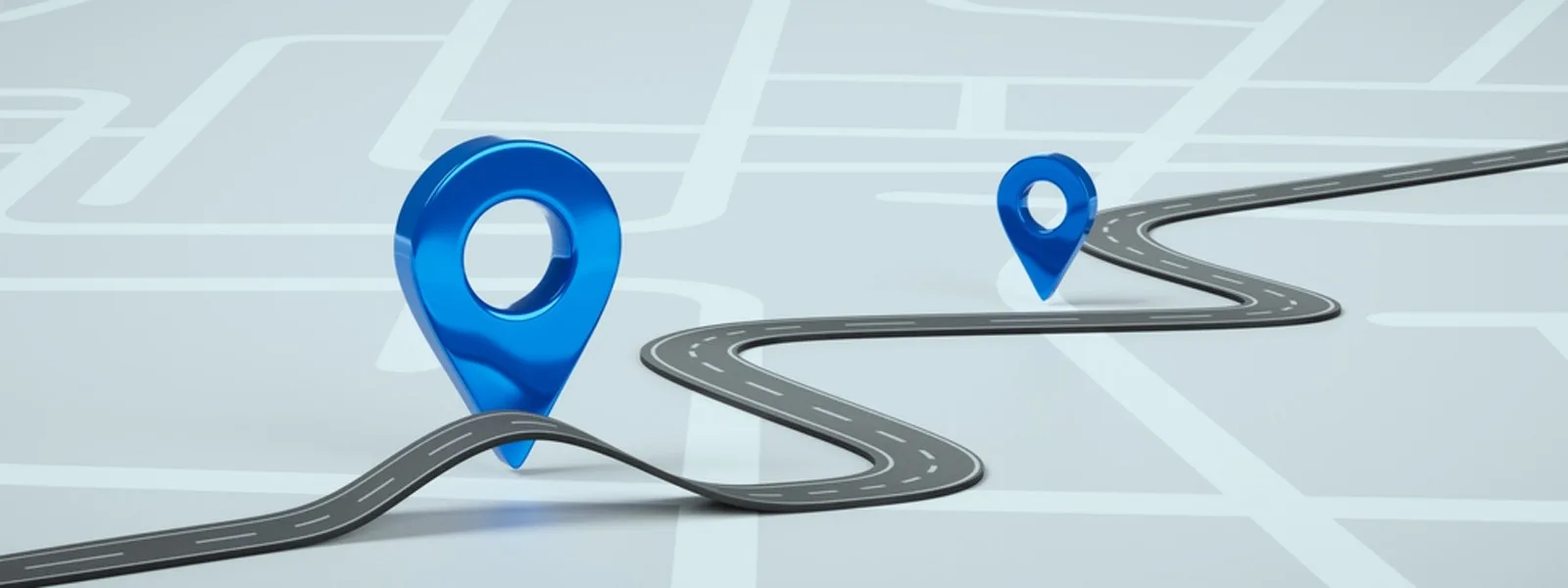
What is Customer Journey Mapping?
Customer journey mapping is a process of visually documenting the steps and touchpoints a customer goes through in their interaction with a company or organization. Customer journey mapping aims to understand and optimize thecustomer experience, identify pain points and areas for improvement, and create more personalized and effective engagement with customers. The map typically includes information about the customer’s goals, emotions, and pain points at each stage of the journey, as well as the company’s touchpoints and interactions with the customer.Why Mapping the Customer Journey is Important?
Mapping the customer journey is pivotal because it helps organizations understand and improve the experiences of their customers. By mapping out the various touchpoints a customer has with a company, businesses can identify areas where they can make the most impact, both for the customer and for the business. Let’s take a look at some of the key points why customer journey mapping is vital to drive the results.1. Prioritize Activities That Make an Impact on Customers and business
It helps to ensure that resources are being used in the most effective way possible. By focusing on activities that have a direct impact on customer satisfaction and business performance, a company can better align its efforts with its goals and objectives. It can lead to increased customer loyalty, improved financial performance, and a stronger competitive position in the marketplace. Additionally, prioritizing activities that make an impact on customers and the business allows a company to more effectively allocate resources, such as time and money, to those areas where they will have the greatest impact.2. Grow a Customer-centric Culture
It ensures a company’s actions and decisions are aligned with the needs and wants of its customers. It prioritizes the customer experience and focuses on meeting and exceeding customer expectations. This can lead to increased customer satisfaction, loyalty, and advocacy, which can drive business growth and improve financial performance.Additionally, it can help to foster a positive and productive work environment. Encouraging employees to focus on the customer, can promote teamwork, collaboration, and a sense of purpose. Furthermore, it can also promote innovation as employees are encouraged to come up with new and creative ways to meet customer needs and improve the customer experience.Plus, it is essential for driving business success, fostering employee engagement and productivity, as well as creating a positive and satisfying experience for customers.3. Implement CX Initiatives With More Confidence and Speed
There are several ways to implement customer experience initiatives with more confidence and speed:- Prioritize initiatives that align with customer needs and business objectives. This will increase the chances of success and provide a clear roadmap for implementation.
- Utilize data and analytics to identify customer pain points and opportunities for improvement. This will provide valuable insights into the customer experience and help guide decision-making.
- Leverage technology to automate and streamline processes. This can help to increase efficiency and speed up implementation.
- Encourage collaboration and communication across teams. This will help to ensure that all stakeholders are aware of the initiatives and are able to provide input and feedback.
- Continuously test and measure the impact of initiatives. This will help to identify areas for improvement and ensure that the customer experience is continually evolving to meet changing needs.
5 Customer Journey Mapping Examples
By understanding the customer journey, businesses can identify pain points and improve the overall customer experience.It is important because it helps businesses to understand the customer’s experience and identify areas for improvement.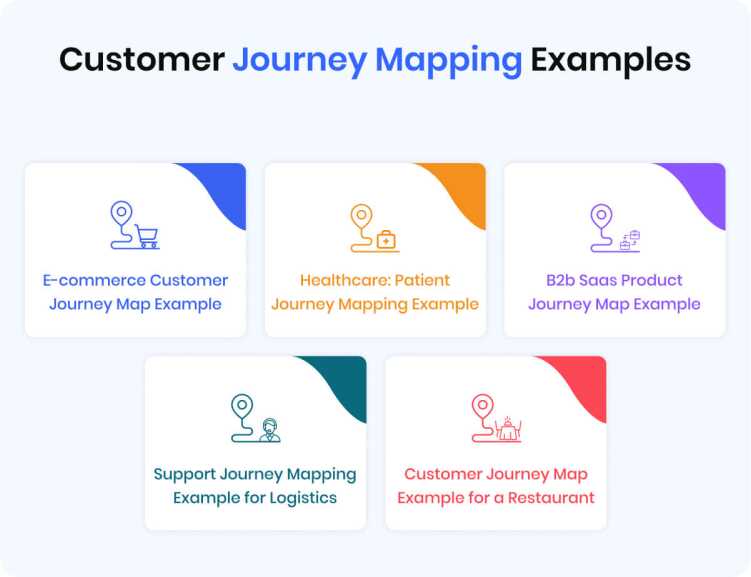 By mapping out the steps a customer takes as they interact with a business, from initial contact to post-purchase follow-up, businesses can gain insight into the customer’s needs, pain points, and expectations.Let’s take a look at some of the customer journey mapping examples.
By mapping out the steps a customer takes as they interact with a business, from initial contact to post-purchase follow-up, businesses can gain insight into the customer’s needs, pain points, and expectations.Let’s take a look at some of the customer journey mapping examples. 1. E-commerce Customer Journey Map Example
It is the process that a customer goes through when interacting with an online store, from the moment they become aware of the store to the moment. They make a purchase and beyond. It encompasses all of the touchpoints that a customer has with the store, including browsing the website, evaluating products, making a purchase, receiving and using the product, and providing feedback.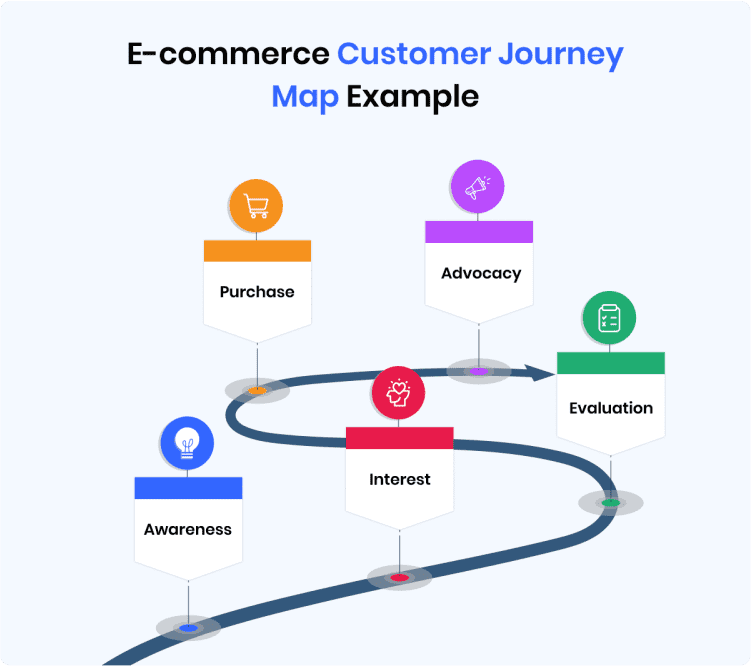 The customer journey map is a visual representation of the customer’s journey, and it can be used to identify pain points and opportunities for improvement in the customer experience. By understanding the customer journey, e-commerce businesses can optimize their website, marketing, and customer service efforts to improve the overall customer experience and increase sales.The journey typically includes several stages, such as awareness, interest, evaluation, purchase, delivery, post-purchase, repeat purchase, and advocacy. These stages are not linear and can vary depending on the specific customer journey.A customer journey map for an e-commerce website might include the following steps:
The customer journey map is a visual representation of the customer’s journey, and it can be used to identify pain points and opportunities for improvement in the customer experience. By understanding the customer journey, e-commerce businesses can optimize their website, marketing, and customer service efforts to improve the overall customer experience and increase sales.The journey typically includes several stages, such as awareness, interest, evaluation, purchase, delivery, post-purchase, repeat purchase, and advocacy. These stages are not linear and can vary depending on the specific customer journey.A customer journey map for an e-commerce website might include the following steps:- Awareness: The customer becomes aware of the e-commerce website through online advertising, social media, search engine results, or word of mouth.
- Interest: The customer visits the website and starts browsing the product catalog, reading product descriptions, and looking at product images.
- Evaluation: The customer evaluates the products and compares them to other options, checking pricing, reviews, and ratings.
- Purchase: The customer makes a purchase by adding products to their cart and going through the checkout process.
- Advocacy: The customer might recommend the website to friends and family, post positive reviews or feedback on social media, or become a repeat customer.
2. Healthcare Patient Journey Mapping Example
It is a process of understanding and documenting the experiences, needs, and interactions of patients as they navigate thehealthcare system. The goal of patient journey mapping is to identify areas where the healthcare system can be improved in order to provide a better experience for patients.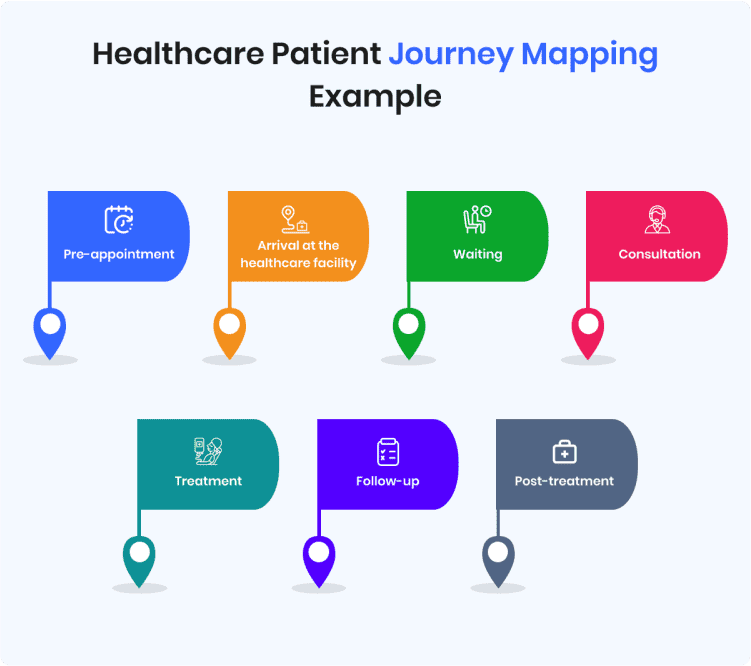 An example of a healthcare patient journey map would be as follows:
An example of a healthcare patient journey map would be as follows:- Pre-appointment: The patient searches for a healthcare provider, schedules an appointment, and receives confirmation.
- Arrival at the healthcare facility: They arrive at the facility and check in.
- Waiting: They wait to be seen by the healthcare provider.
- Consultation: The patient meets with the healthcare provider, discusses symptoms and concerns, and receives a diagnosis.
- Treatment: They receive treatment, such as medication or a procedure.
- Follow-up: Schedules a follow-up appointment and receives instructions for post-treatment care.
- Post-treatment: The patient receives follow-up care and monitoring.
3. B2b SaaS Product Journey Map Example
A B2B SaaS (Software as a Service) product journey map is a visualization of the steps a customer takes as they interact with a B2B SaaS product. The map helps to understand the customer’s needs and pain points and identify opportunities for improvement.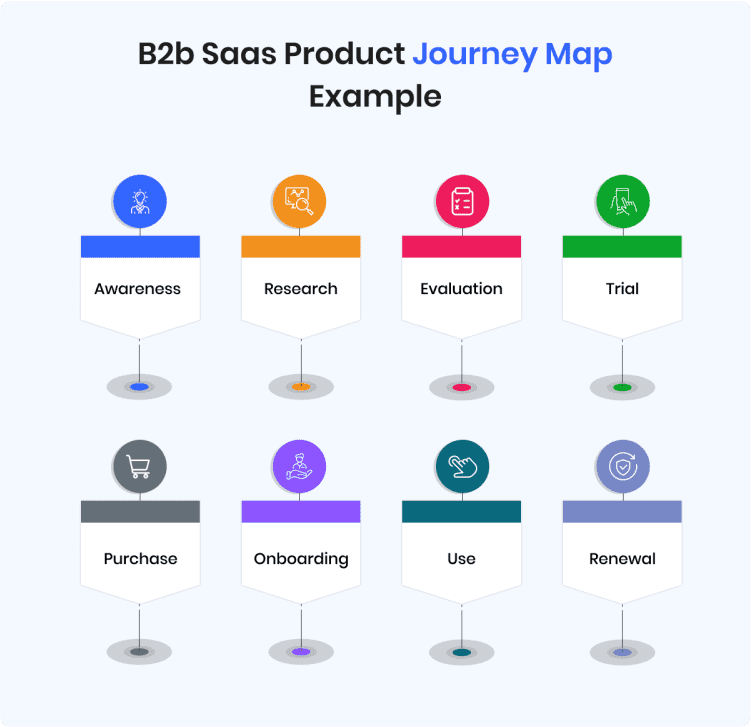 An example of a B2B SaaS product journey map would be as follows:
An example of a B2B SaaS product journey map would be as follows:- Awareness: The customer becomes aware of the SaaS product through marketing campaigns, industry events, or word of mouth.
- Research: The customer researches the SaaS product, reads reviews, and visits the company’s website to learn more.
- Evaluation: The customer evaluates the SaaS product, comparing it to competitors and determining if it meets their needs.
- Trial: The customer signs up for a free trial of the SaaS product, testing it out and getting a sense of how it works.
- Purchase: The customer decides to purchase the SaaS product, submitting payment and receiving login credentials.
- Onboarding: The customer is walked through the process of setting up the SaaS product and learning how to use it.
- Use: The customer uses the SaaS product on a regular basis, and may reach out to customer support for assistance.
- Renewal: The customer decides whether to renew their subscription to the SaaS product.
4. Support Journey Mapping Example for Logistics
Support journey mapping is a process of understanding the experience of customers as they interact with a company’s support team. This can be especially important for logistics companies, where timely and effective customer support is crucial for maintaining positive relationships and meeting delivery deadlines.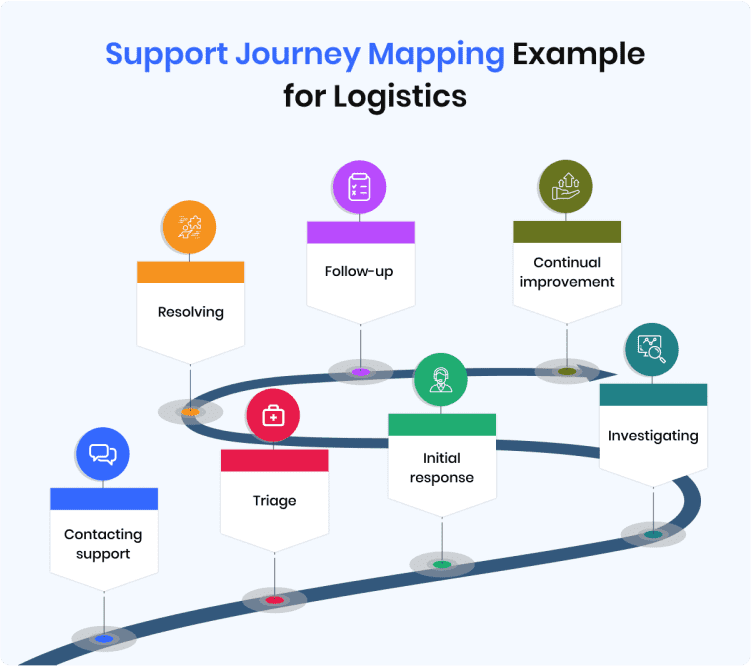 An example of a logistics support journey map would be as follows:
An example of a logistics support journey map would be as follows:- Contacting support: The customer contacts the logistics company’s support team via phone, email, or online chat.
- Triage: The support team triages the customer’s request, determining the appropriate level of assistance.
- Initial response: They provide an initial response to the customer’s request, such as acknowledging receipt of the request or providing a tentative solution.
- Investigating: The customer support team investigates the customer’s request, gathering more information and looking into possible solutions.
- Resolving: Resolves the customer’s request, providing a solution or taking action to resolve the issue.
- Follow-up: They follow up with the customer to ensure that the issue has been fully resolved, and to gather feedback on the support experience.
- Continual improvement: Based on customer feedback, the logistics company continuously improves the support process.
5. Customer Journey Map Example for a Restaurant
A customer journey map for a restaurant is a visualization of the steps a customer takes as they interact with a restaurant, from the moment they decide to dine out until they leave the restaurant.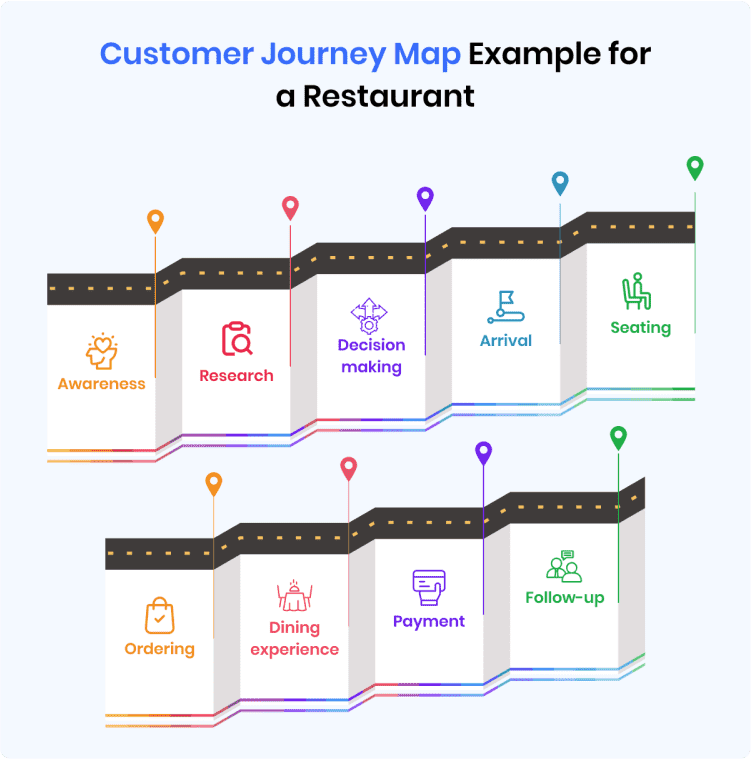 The map helps to understand the customer’s needs and pain points and identify opportunities for improvement.An example of a customer journey map for a restaurant would be as follows:
The map helps to understand the customer’s needs and pain points and identify opportunities for improvement.An example of a customer journey map for a restaurant would be as follows:- Awareness: The customer becomes aware of the restaurant through marketing campaigns, word of mouth, or searching for restaurants online.
- Research: The customer researches the restaurant, looking at the menu, reading reviews, and checking the restaurant’s website.
- Decision making: The customer decides to visit the restaurant and makes a reservation or chooses to walk-in
- Arrival: The customer arrives at the restaurant and is greeted by the host or hostess.
- Seating: The customer is seated at a table and presented with the menu.
- Ordering: The customer places an order with a server and receives their food.
- Dining experience: The customer enjoys their meal and experiences the atmosphere of the restaurant
- Payment: The customer receives their bill and pays for their meal.
- Follow-up: The customer may leave feedback or a review of their dining experience.
Best Customer Journey Mapping Tools
Mapping tools are important because they help businesses to easily and effectively create customer journey maps, even if they have little or no experience. Tools also offer a variety of features that make it easy for businesses to understand the customer’s experience, identify pain points, and identify opportunities for improvement.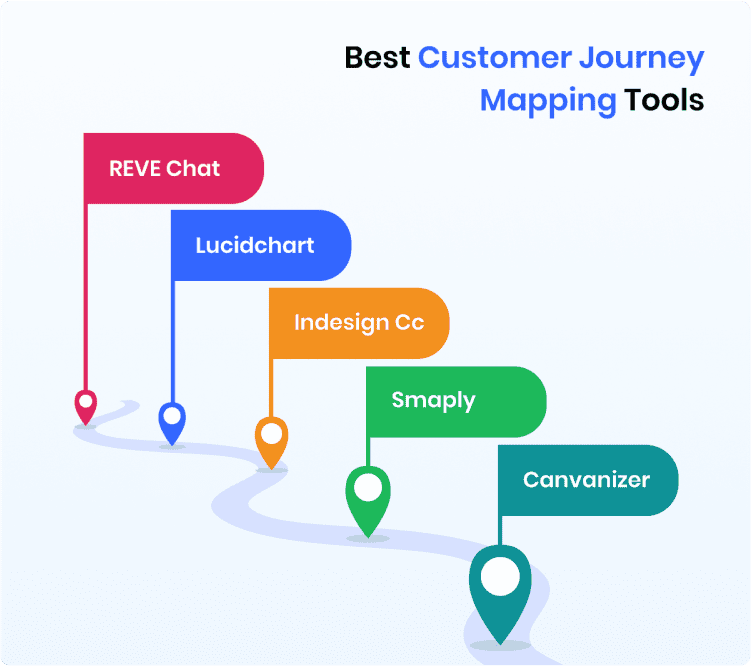 Let’s take a look at some of the best customer journey mapping tools.
Let’s take a look at some of the best customer journey mapping tools. 1. REVE Chat
It is a customer journey mapping tool that allows businesses to track and analyze customer interactions across multiple channels, such as website chat, email, social media, etc. With REVE Chat, businesses can create a comprehensive view of the customer journey, from initial contact to post-purchase follow-up.Some of the key features of REVE Chat include.- Multi-channel customer journey mapping: It allows businesses to track customer interactions across multiple channels, including website chat, email, and social media.
- Real-time analytics: It provides real-time analytics that allows businesses to see how customers are interacting with their brand, and identify areas for improvement.
- Automated workflows: Automated workflows allow businesses to streamline customer interactions and improve efficiency.
- Customer segmentation: It allows businesses to segment customers based on demographics, behavior, and other criteria, making it easier to target marketing and support efforts.
- Integrations: It can integrate with other tools such as CRM, analytics, e-commerce platforms, and marketing automation software.
2. Lucidchart
It allows businesses to create visual diagrams and flowcharts to map out the customer journey. It also helps businesses to understand the customer’s needs and pain points, and identify opportunities for improvement.Some of the key features of Lucidchart include.- Drag-and-drop interface: Its drag-and-drop interface makes it easy for users to create customer journey maps, even if they have little or no experience with design tools.
- Pre-built templates: Offers a wide range of pre-built templates for customer journey mapping, making it easy for businesses to get started.
- Collaboration: Lucidchart’s collaboration features allow multiple team members to work on the customer journey map together in real-time.
- Integration: It can integrate with other tools such as G-Suite, Trello, and Slack.
3. Indesign
Adobe InDesign CC is a design and layout software that can be used to create visual diagrams and flowcharts, and this tool is ideal to create customer journey maps, but it is not a specific customer journey mapping tool.Some of the key features of InDesign CC include.- Advanced typography: InDesign CC offers advanced typography features, allowing users to create professional-looking diagrams and flowcharts.
- Vector graphics and image editing: It offers vector graphics and image editing tools, allowing users to create and edit diagrams, illustrations, and other visual elements.
- Collaboration: It allows multiple team members to work on the customer journey map together by using Adobe’s collaboration feature called “Adobe Creative Cloud”.
- Integration: InDesign CC can integrate with other tools such as Photoshop and Illustrator.
4. Smaply
- Drag-and-drop interface: This makes it easy for users to create customer journey maps, even if they have little or no experience with design tools.
- Pre-built templates: It comes with lots of pre-built templates that help the user to design a diagram to clearly illustrate the customer journey over time.
- Collaboration: It comes with a collaborative tool that features multiple team members working on the customer journey map together in real-time.
5. Canvanizer
To map out the customer journey Canvanizer is a great tool. It comes with all the effective features to map out the entire customer journey. Some of the key features of Canvanizer include.- Drag-and-drop interface: Canvanizer’s drag-and-drop interface makes it easy for users to create customer journey maps. With Canvanizer, you don’t need any design experience. Simply, drag-and-drop the pre-built templates and customize them based on your needs.
- Customizable elements: It allows you to customize the elements of the customer journey map, such as icons, colors, and labels, to match your brand.


